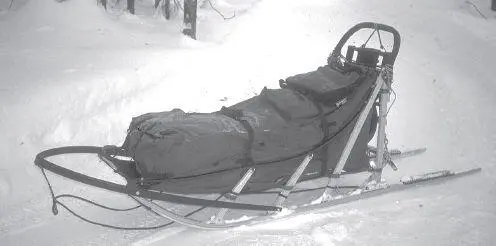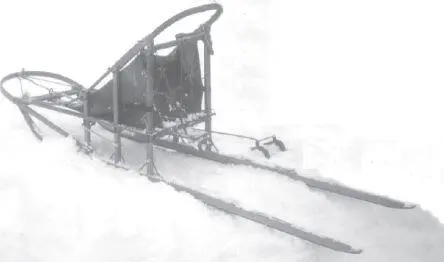As each dog gets its pan full of food, the din gradually subsides. After the last morsel is ferreted out and the last dish is licked clean there is always a period of complete silence. The dogs are quietly looking at us. It seems as if they are making mental notes, recording who we are, and that we have brought them food and affection once again.
And later — always — comes the thank-you song. One dog will start it with a howl and the rest will join in. Those who can’t howl, bark. Slipper, the old but still excellent leader who spent many years with Libby Riddles, has more than a touch of hound in her family tree. She has an unmistakable comical throaty bellow somewhere between a bay and a bark, and she sounds as if she has a raccoon treed deep in the Georgia woods. Silvertip is her counterpoint, throwing his head back and making the forest echo as hauntingly as his not-so-distant wild cousins.
The wave of sound reaches a climax and continues for several minutes. The effect is other-worldly. Every musher will always stop to listen and none will ever make any move to disturb the purity of the moment.
There’s no doubt the dogs are talking to us, thanking us for their food and care, telling us we are part of their pack. They are reaffirming the age-old bond between humans and dogs that seems to reach its culmination in the dog team.
October 22, 1994
Montana Creek, Alaska
At last I’m back on the runners. Thanks to last week’s storm, we decided to hook up the sleds today for the first time this season. There really isn’t much snow, maybe only a couple of inches, but it’s enough. After playing musher on a four-wheeler all summer and fall, I’m finally back to the real thing.
About mid-afternoon, I hook up five dogs to Bert’s Bernie Willis sled, the same one he used on the 1993 race, and which Bruce Moroney used this year. Willis sleds are very flexible and are built to give; in fact, they give a lot, and seemingly feel like they’re about to fall apart. This is my first time to ride one and I’m not at all used to its very tippy nature.
The dogs are beside themselves with anticipation. They know this is the first run on snow with the sled and are positively supercharged. When I pull the slipknot in the tie-off rope the sled shoots out of the lot like it was fired from a cannon. Unfortunately, our outbound trail makes a tight S-turn, which I impressively don’t negotiate. The sled flips instantly and I drag through the brush with a death grip on the handlebar, yelling “Whoa!” at the top of my lungs.
Old Socks is leading. He’s done all this before to more mushers than I can count. He knew the sled would whiplash and spill on a turn like this, and I’m sure he’s been laughing to himself from the moment we started hooking up. Of course, he also knows to stop the team when the sled goes over on its side, but he makes sure he goes just far enough extra to make me think he’s going to leave me behind.
I manage to hang on somehow and get everything upright in a few seconds. As soon as my feet touch the runners, Socks is off again. We tear across our backyard, half-mile-wide swamp at breakneck speed, and I have no doubt the neck in question is mine. There isn’t nearly enough snow to make a smooth trail. It’s like riding a bicycle over railroad ties at 20 miles an hour as the sled flies from one crest to the next with a knee-buckling series of crashes and thuds. At least twice within a half mile we hit boulder-size bumps while I’m off balance, leaving me looking up at the south end of my northbound wheel dogs and imploring them to stop in my very best and most authoritative “playground voice.”
We finally roar off the swamp onto the overland trail. Unlike the four-wheeler, I don’t have a lot of choice about which side of the trail the sled uses. Almost immediately one runner settles into a deep rut on the right side; I’m suddenly up close and personal with every overhanging branch and limb. On the outside of one turn a particularly thick clump of willow bushes literally rips me from the sled. Fortunately I have the tie-off rope wrapped around my wrist and am only dragged 20 yards or so before Socks figures he’s made his point and stops the team.
I realize I have to learn to ride this sled. All I can do is hop back on and wait for the next face full of snow. After a couple more belly dances with Mother Earth, I begin to get the hang of it. The Willis sled does have a good feel to it, but it’s an acquired taste, sort of like single-malt Scotch whiskey or sushi. It leans and sways, but if I can control it, it’s like riding a pair of cross-country skis. As I figure out how to shift my weight and play the brake and the drag (a piece of snowmachine track tied behind the brake), and I find I have a lot more control than I think, particularly on turns.
After 10 miles, we sweep back into the lot. I haven’t gone down for the last four miles, and I begin to think maybe this dog-mushing thing will work out after all. Whether my battered body will survive long enough to see the payoff is another matter, however. I wonder if Martin Buser and the other Big Names went through a stage like this?

Basket sleds are constructed to be relatively lightweight, flexible, and maneuverable, with an elevated “basket” supported on stanchions several inches above the runners. The handlebar is an integral part of the basket structure. Most Iditarod mushers run variants of basket sleds for the latter part of the race. This is a Bernie Willis model.

Sprint sleds are built to be as lightweight as possible. Some barely weigh 20 pounds. The basket on a sprint sled is very small and the handlebar is located close to the midpoint of the runners to better spread the driver’s weight.
October 29, 1994
Montana Creek, Alaska
As if to celebrate the first real subzero night of the season, the northern lights come out.
All evening they teasingly show themselves in the north, each wave venturing ever more southward and hinting of glories to come. After a break to visit the local lodge for dinner, Barrie, Ron, and I return to finish running the dogs.
About 11, before we get back on the trail, the display begins in earnest as the northern sky begins to glow from horizon to horizon. A bright band of green hovers low, just beneath the Big Dipper. Sensing the show is about to start, I walk out to the road for a better view.
I don’t have long to wait. Within a few minutes soaring spikes and swirls materialize overhead, creating the effect of a Gothic cathedral with iridescent columns of light reaching to the zenith. Simultaneously the northern band of luminescence grows steadily brighter and broader, starkly silhouetting the delicate tracery of the bare birch branches. The intensity continues to increase until I can actually see shadows on the snow-packed road.
Then about 11:30 the northern sky explodes in one of the most amazing displays I’ve ever seen. For 10 minutes, frantically shifting curtains tipped in brilliant crimson race in all directions. The northern third of the sky is completely chaotic, seething and swirling like some glowing, ghostly thunderstorm. Fully formed multi-hued curtains suddenly appear and disappear, tumble and stabilize, careen apart and randomly collide.
The sky is alive and seems to be churning perceptibly closer to me. Now I begin to understand why some traditional Inupiats fear the lights can steal their souls: if I were alone on the winter tundra without the comforting 20th-century knowledge of what really drives the auroral displays, this writhing creature of light might be utterly terrifying.
Читать дальше














